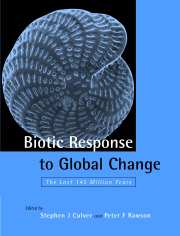13 results
Filling the gap: new precise Early Cretaceous radioisotopic ages from the Andes
-
- Journal:
- Geological Magazine / Volume 152 / Issue 3 / May 2015
- Published online by Cambridge University Press:
- 26 January 2015, pp. 557-564
-
- Article
- Export citation
Preface
-
- Book:
- Biotic Response to Global Change
- Published online:
- 14 August 2009
- Print publication:
- 24 July 2000, pp xiii-xiv
-
- Chapter
- Export citation
Index
-
- Book:
- Biotic Response to Global Change
- Published online:
- 14 August 2009
- Print publication:
- 24 July 2000, pp 474-501
-
- Chapter
- Export citation
7 - The response of Cretaceous cephalopods to global change
-
-
- Book:
- Biotic Response to Global Change
- Published online:
- 14 August 2009
- Print publication:
- 24 July 2000, pp 97-106
-
- Chapter
- Export citation
References
-
- Book:
- Biotic Response to Global Change
- Published online:
- 14 August 2009
- Print publication:
- 24 July 2000, pp 399-473
-
- Chapter
- Export citation
1 - Introduction
-
-
- Book:
- Biotic Response to Global Change
- Published online:
- 14 August 2009
- Print publication:
- 24 July 2000, pp 1-3
-
- Chapter
- Export citation
26 - The biotic response to global change: a summary
-
-
- Book:
- Biotic Response to Global Change
- Published online:
- 14 August 2009
- Print publication:
- 24 July 2000, pp 391-398
-
- Chapter
- Export citation
Contents
-
- Book:
- Biotic Response to Global Change
- Published online:
- 14 August 2009
- Print publication:
- 24 July 2000, pp v-x
-
- Chapter
- Export citation
Frontmatter
-
- Book:
- Biotic Response to Global Change
- Published online:
- 14 August 2009
- Print publication:
- 24 July 2000, pp i-iv
-
- Chapter
- Export citation
List of contributors
-
- Book:
- Biotic Response to Global Change
- Published online:
- 14 August 2009
- Print publication:
- 24 July 2000, pp xi-xii
-
- Chapter
- Export citation

Biotic Response to Global Change
- The Last 145 Million Years
-
- Published online:
- 14 August 2009
- Print publication:
- 24 July 2000
The ammonite sequence in the Agrio Formation (Lower Cretaceous), Neuquén Basin, Argentina
-
- Journal:
- Geological Magazine / Volume 134 / Issue 4 / July 1997
- Published online by Cambridge University Press:
- 01 July 1997, pp. 449-458
-
- Article
- Export citation
The Carroll Rating Scale for Depression I. Development, Reliability and Validation
-
- Journal:
- The British Journal of Psychiatry / Volume 138 / Issue 3 / March 1981
- Published online by Cambridge University Press:
- 29 January 2018, pp. 194-200
- Print publication:
- March 1981
-
- Article
- Export citation

